
Passengers pose for photographs before boarding a train specially for senior travelers at a railway station in Shanghai. LIU WEIXING/XINHUA
With the world's largest aging demographic — projected to see over 400 million people aged 60 and above by 2035 — China is leveraging its vast domestic market and robust industrial infrastructure to grow the silver economy, analysts said.
By doing so, China is not only improving the well-being of senior citizens, but also unlocking new avenues for economic growth and innovation, they said, adding that China's experience can offer insights for other developing countries that are still relatively young in their demographic transition.
With currently around 300 million people aged 60 and above, China is home to the world's largest elderly population, and roughly one in every four seniors globally, said Zhang Ming, deputy director of the Institute of Finance and Banking, which is part of the Chinese Academy of Social Sciences.
While some view this demographic shift as a burden, Zhang focuses on the consumption power of this group and the strong impetus it would provide to the development of the silver economy.
Moreover, China has a relatively complete industrial chain, supply chain and innovation capacity, which provide the necessary technological and production conditions to drive the silver economy forward, Zhang said.
By 2035, the silver economy might grow from 7 trillion yuan ($970 billion) in 2024 to 30 trillion yuan, said the China Research Center on Aging. While economist Ren Zeping said that elderly consumption is predicted to reach 40-69 trillion yuan by 2050, or up to 20.7 percent of the nation's GDP.
Over the years, China's silver economy has taken root and flourished across the country, with a continuous stream of new and vibrant consumer trends emerging as the population's desire and ability to enhance their quality of life steadily grows.
The consumption structure, especially among those born in the 1960s and after, is gradually evolving towards a more self-gifting orientation, with a larger emphasis on product quality, consumption experiences and the expression of personal values, said Liu Ming, director of the Department of Social Development under the National Development and Reform Commission.
"We are witnessing a convergence in the consumption mindsets and structures of the elderly and the young, where the traditional lines separating their preferences and behaviors are gradually fading," Liu said.

Senior travelers engage in conversation during a train trip from Tianjin to tourist attractions in South China. SUN FANYUE/XINHUA
Older consumers are now more inclined toward activities and platforms that were once primarily associated with the younger generation, such as online shopping, livestreaming and smart gadgets, Liu said.
According to a survey conducted by the People's Bank of China last year — the country's central bank — residents aged 56 to 64 hold more assets compared to other age brackets, positioning them as a key demographic in the silver economy market.
The survey also revealed that there was a notable shift in consumer behavior and preferences for the aging population between 2014 and 2020, with older adults increasing their investments in social engagement, healthcare and retirement financial services.
On the other hand, the younger generation is also actively engaging with the silver economy, with online shopping becoming a means for many young people to fulfill their filial piety duties. Moreover, the presence of young individuals in elderly canteens and travel groups is becoming more prevalent, Liu added.
Going forward, China needs to weave an even stronger social safety net for senior citizens to steer clear of their concerns about eldercare and medical services, thus making them feel more secure about their financial situation and more willing to spend, said Cai Fang, chief expert of the National High-end Think Tank of the Chinese Academy of Social Sciences.
"We must ensure that the elderly are treated as a normal consumer group, rather than a marginalized segment, in order to sustain China's consumption expansion and unlock its inherent growth capacity," Cai said.